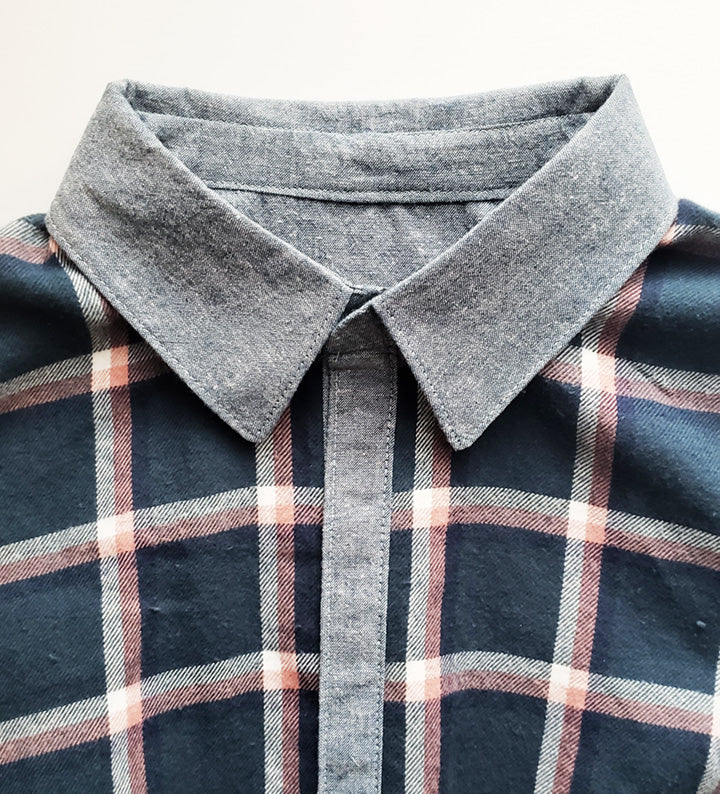
Shirtmaking: An Alternate Method for Making a Collar
If you are making Version A of the Byrdie Button-up (or really, any shirt with a traditional shirt collar), then the following method of making the collar will give you a nice result and a collar that wants to stay in place. This is a technique adapted from the book: Shirtmaking, Developing Skills for Fine Sewing by David Page Coffin (this was basically my bible while making loads of shirt samples for this pattern!). (not an affiliate link)
In the original Byrdie instructions, I showed an easier collar making method with the intention of expanding on shirtmaking techniques for those of you that want to take your shirtmaking skills to the next level and add more to your construction skillset.
The method I am showing you today (that I’ve had photographed since three months ago…sorry for the delay!) gives the collar more structure and a shape that naturally stays in place for a more crisp finish. We’ll also be attaching the collar to the collar stand and then the collar stand to the bodice differently.
So here we go!
Prepare the collar pieces
Cut the collar stand and collar pattern pieces as instructed (two of each), plus the interfacing for each (one of each).
Trim 1/4” off each short end of one of the collar pieces (this will be the under collar).

Now trim the collar interfacing by 1/2” on three sides (only the interfacing for the collar, not the collar stand). The bottom edge of the collar interfacing will be untrimmed.
You can use non-fusible interfacing here, but all I had on hand was fusible, so that’s what I used and it worked out well. If using non-fusible, you can glue-baste the collar interfacing to the upper collar (the piece that is not trimmed). If using fusible, go ahead and fuse the interfacing to your upper collar piece, leaving a 1/2” of the collar extending around all edges.

Sew the collar pieces together
Right sides together, pin the two collar pieces together, matching all the edges. The trimmed collar piece will be slightly shorter in length, so you’ll have to stretch the ends to meet the untrimmed piece edges.

Start sewing along the short edge of one side at 5/8” until you reach the corner (if you used non-fusible interfacing here, you’ll want to just catch the very edge of the interfacing in your seam). Then pivot and sew approximately 1” on the long side. Pause here and gently stretch the collar to allow the edges of both pieces to align and lay flat (you’re stretching the shorter piece to match up with the longer piece). Stop 1” from the corner and sew without stretching until you reach the corner. Pivot and sew along the remaining short edge to complete the seam.


Your collar will be taught on one side and more slack on the other side. The taught side will help to pull the longer side down when the collar is finished.


Trim the seam allowance to about 1/8” and turn the collar right side out, poking out the corners and pressing the edges out fully.


As you press, you can pull the collar over the edge of the ironing board or around a tailor’s ham to preserve the shaping.


Topstitch or edgestitch along the perimeter of the pressed collar. Again, use the same stretching technique as you sew along the longer edge to pull the shorter collar piece taught and preserve the shaping, ensuring there are no puckers in the topstitching.

Fold and shape the unfinished collar edge at the seam allowance
Fold and press a 5/8” seam allowance in the raw edge of the collar assembly toward the more taught side (the under collar). As you do this, pull the upper collar edge (the more slack side) to align the raw edges (it may not be perfectly aligned and that is ok, just get it close). Press the fold well.


Wrap the collar around a tailor’s ham, maintaining the fold you just pressed, and press to shape the collar and folded edge to curve around it (just like it would curve around your neck when installed on the shirt—looking at my photos, I accidentally did mine kinda upside down! But it still worked out okay, proof that little mistakes are not dealbreakers ;) ).


To secure the collar shape, sew along the folded edge at 1/2”—just inside the seam allowance—tacking the raw edges of the upper and under collars together. Keep the collar turned at a near 90 degree angle next to the presser foot of your machine as you sew.


Now the collar is ready to be attached to the collar stand!
Attach the collar stand to the neckline
Start with the upper collar stand (this piece will be visible on the exterior of the shirt). Right sides together, attach the bottom edge of the collar stand to the exterior side of the shirt at the neckline with a 1/2” seam allowance. You should have 5/8” of collar stand extending beyond the button placket on either side.


Clip the seam allowance at 1/2” increments to allow the curved neckline a bit more flexibility.
Now flip the shirt over so that the wrong side (interior) is facing you. Align the under collar stand right side down along the neckline, matching the center back and sandwiching the shirt neckline between the collar stands. Starting from the center back, sew toward the center front, gently stretching the under collar stand so that it extends about 1/8” beyond upper collar stand at the end. Then repeat the process on the opposite side.


I got a liiiiittttle overzealous with my stretching here, but it’s ok! Again, mistakes are not dealbreakers (trying to convince myself). Breathe.
Trim the seam allowance to 1/4”.

Mark the collar location on the collar stand assembly
Align the collar against the collar stand so that it is perfectly centered. Mark the collar stand where the edges of the collar fall. This is where you will stop the seam on either side in the next step. Set the collar aside for now.

Trim the overlap at the ends of the collar stand so that the seam allowance is even at the ends.


Sew the ends of the collar stand together
Roll the edge of the shirt/button placket into the collar stand assembly. You want to clear the curved end of the collar stand to the point that you marked in the last step.


It helps to mark the seam allowance (5/8”) here before sewing. Pin the collar stand ends together.


Sew a 5/8” seam to the point you marked in the last step, making sure you don’t sew through the part of the shirt that is rolled up into the collar stand assembly.
Trim the seam allowance to 1/8”. Repeat for the opposite side.



Turn the collar stand right side out
Tug on the button plackets to pull the collar stand ends right side out. When the entire collar is turned out, press all the edges well, making sure the ends at the collar stand are fully extended. The unsewn edges will be at the top of the collar stand, leaving an opening for attaching the collar. Try on the shirt to double check that the opening you left for the collar is centered where you want it.



Attach the collar to the collar stand
Clip the under collar stand raw edge (on the interior side of the shirt) at the corners of the opening. This will allow the raw edge to lay flat for installing the collar.


Align the collar assembly—with the upper collar face down—with the collar stand edge that you just clipped, centering the collar. You’re only sewing the collar to this side of the collar stand in the step, so make sure the other side of the collar stand is out of the way.



Sew the collar to one side of the collar stand with a 5/8” seam allowance. You’ll sew right along the fold of the collar, concealing the 1/2” seam along the fold in your seam allowance. Trim the seam allowance to 1/4”

Finish the collar
Almost there!
Now flip the collar up so that the seam allowance is inside the collar stand. Fold the seam allowance in on the opposite side of the collar stand, aligning it to conceal the seam you just sewed.


Topstitch the entire perimeter of the collar stand, closing the collar stand opening and securing the collar in place. You’ll have to stretch the under collar stand as you sew to avoid puckers in the upper collar stand (since we stretched it a few steps back).



The fold of the collar that you pressed when prepping the collar will keep your collar neatly turned without having to fight with it or pressing it into place from now on!

This has become my favorite way to sew a collar. It requires a little more prep work, but the end result is much more predictable and cleaner. I’ve had a chance to wear this flannel shirt quite a lot (since it took me fo-eveh to get this blog post up!) and the collar has maintained great shape even after multiple washes (and I never have to iron it!).
I also created a yoke for this Byrdie, and you can see a blog post all about how to do that here!
Happy sewing!
